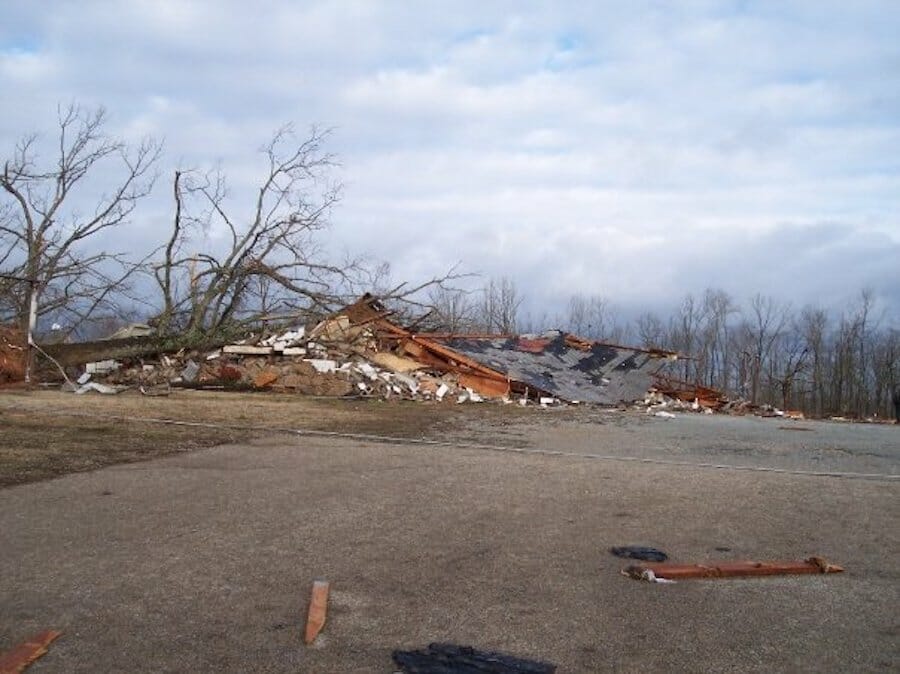Tornado warnings are a blessing of modern technology and have saved countless lives since the first warning was issued in 1948. Preparation is still a significant factor and merely having a warning system isn’t enough unless we take necessary precautions to protect ourselves and our homes as much as possible.
No one wants to think about their home being hit by a tornado. The destruction can be devastating and even deadly. But planning can make it easier to pick up the pieces if a tornado does hit your home–it might even save your life.
The best time to plan for a tornado is long before watches or warnings are ever issued. If you are involved in your home building process, you can even include safety measures during construction. If you’re moving into existing construction, there are still things you can do to protect your family.

Tornado Safety in New Construction
When building a home, there are so many things to consider. In addition to selecting the right paint color or the perfect countertops, you need to consider ways to make your home safe for your family.
Tornado-Resistant Construction – Homes can be built in such a way that they can withstand high winds. You want to discuss this with your builder but methods to consider include:
- Continuous Load Path – This can protect a home from damaging winds by diverting uplift and lateral loads from high winds away from the roof and walls and into the foundation and ground.
- Impact-Resistant Walls – Several methods exist for creating impact-resistant walls. Your builder can help you find the right option for you.
- Durable Roof Construction – Home destruction often begins at the roofline. Building a roof that can withstand a tornado’s winds for longer periods of time can help prevent the remaining structure’s destruction.
- Tornado-Resistant Flooring – Proper spacing of floor joists can help loads to reach the ground.
Tornado Safety in Existing Buildings
When it comes to tornado safety in an existing home, there may not be much you can do to change the structural integrity. Still, you can make some critical decisions regarding selecting the best refuge area within your home.
- Size – Choose an area that will fit everyone in your home.
- Lowest Floor – A room in the basement or on the lowest floor of your home will provide the best chance of survival.
- Interior Location – A room that has no exterior walls is the best choice.
- Avoid Interior Hazards – Avoid rooms with tall shelves and large windows.
- Avoid Exterior Hazards – Consider the possibility of outdoor hazards such as falling trees, utility poles, and chimneys.
Safe Room Construction
Safe rooms can be in-residence or stand-alone structures attached to or near an existing home. These rooms have “hardened” walls and are designed to meet FEMA engineering guidelines and protect against wind forces and the impact of wind-borne objects.
Storm Shelters
Storm shelters and safe rooms are similar, but safe rooms must meet stricter standards set by FEMA. Storm shelters are often less expensive and are a great option if you cannot alter your home construction. You can have tornado shelters installed inside your home, in a garage, or in your yard and they can be above or below ground. Just like safe rooms, storm shelters are designed to provide “near-absolute protection” against tornadoes.

A Few Safety Tips
Once you have determined a refuge area or build a safe room or storm shelter, it’s important to be prepared for weather events.
- Weather Radios – A battery-powered weather radio is essential, so you can continue to get weather alerts even if the power has gone out or you have a shelter without electricity.
- Medical Supplies – Stock your shelter area with a basic first aid kit. It’s also vital to include necessary medications for all members of your household.
- Flashlights and Batteries – Keep a fresh supply of flashlights and batteries on hand.
- Food and Water – Include a few shelf-stable snacks and water in your shelter if rescue is delayed.
- Blankets – A few blankets can keep you warm if you get wet and provide a make-shift bed if you are in the shelter for an extended time.
Arkansas Shelter Companies
Check out one of these manufacturers or installers to get a quote for a storm shelter or safe room.
Arkansas Storm Shelters – Russellville
4142 East Main St
(479) 967-7233
Website
Cozy Caverns Storm Shelters – Austin
135 Parris Ln #9111
(501) 920-7460
Website
Tornado Shelter Systems – Beebe
2414 Dewitt Henry Dr
(501) 941-1005
Little Red Storm Shelters – Heber Springs
247 Cut Off Ln
(501) 250-4203
Website
Safe Home Shelters – Mulberry
11511 Beneux Bottom Rd
(479) 414-1947
Website
Storm Shelters NWA – Springdale
2231 Lowell Rd
(479) 879-5903
Website
My Safe Place Tornado Shelters – Jonesboro
(870)530-2831
Website


